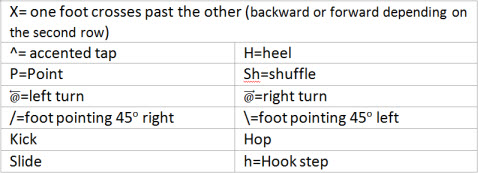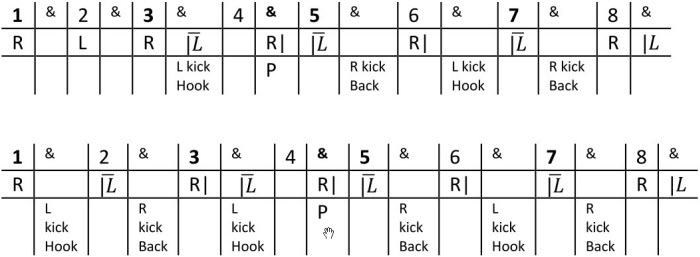
Salsa, Mambo & Cha Cha Cha footworkSalsa or Mambo footwork can be thought of in terms of Executing the basic steps correctly is a matter of following the music (being ‘in time’ with the music) and with what beats of the music you need to sync your footwork; the latter depends on the style you dance. We explain these two concepts here, here and here When we dance with a partner usually we execute the basic steps following the regular beat on the music. How the feet move however, may change depending on what turn patters we execute. Fortunately, while there are an infinite number of turn pattern combinations, these are usually made up by combining only 13 footwork elements. We describe these in details in our DVD From Salsa to Mambo (via Cha Cha Cha)where we include exercises which both male and females can practise solo at home until they are fully mastered. At times dancers release the hand hold and they may dance solo for a few bars of music. Here is where they may wish to improvise with some solo footwork. This footwork may be choreographed (that is, learn by memory and praticsed extensively in front of a mirror) which is usually referred to as shines or pasitos. Other times dancers my feel to improvise this footwork to fit the music they dance to and we do like this much better :) . For an amazingly inspirational example, have a look at the clips in the Introduction of our DVD Salsa on the Spur of the Music. Very skilled advanced dancers may be able to improvise their footwork while they execute turn patterns, as here.. In this page we describe a method we developed to annotate salsa and mambo footwork. It consists of a set of symbols for different foot actions and the timing such actions occurs within the bar of music. It is really nothing but a music score for salsa and mambo footwork. As everything which uses symbols, initially it may look scary but believe us, it is very simple. You can make two uses of this method: In what follows you can find the list of symbols used, the explanation of the method and the notation for all the footwork contained in our DVD .. The footwork 'score'Think of this as the equivalent of a music score. We have 3 lines. The first line gives the music beats; these go from 1 to 8 and cover 2 bars of music, as it is customary in salsa and mambo. in between each beat of music we have the 'and' step. If you are familiar with music theory, this is the 16th of a beat. If you are not familiar with music theory, this is what dance teacher may call 'and 2', 'and 3'... or quick step, or syncopations although this term is not strictly correct). This line shows us that if we wanted to step to all beats or the music and all '&' beats we could perform 16 steps in 2 bars of music.
The second row, tells us what foot needs to step at that specific beat. Where L=left foot, R=right foot. And empty cell means that there is no step at that beat. For example, this figure shows that the left foot steps at beat 1, we rest at beat 2, the right foot steps at beat 3, etc. In this row we also write 'where' the foot steps. This of yourself in a resting position, feet slightly apart. We call that the 'default' position. That is where the left foot 'normally steps (L) and the right foot normally steps (R). Now imagine you move your left foot forward and in a normal basic step. To show that left foot has moved forward we put a bar underneath it (L). In other words, the bar is the reference of the foot default position. A right foot stepping backward as in the standard basic steps would be R̄. The same applies for movement sideways. We list here some examples.
It is easier to see it that to describe it by words, as in this example.
Finally the last row. This describes 'how' the foot steps, as follows
And here is an example of how to read the third row in the footwork score:
Salsa-Mambo Footwork examplesWhat follows are example of free style footwork. They are taken from our DVD Timing Exercises Vol 3 to which you can refer if you want to study them and exercise to them. As explained in the DVD page, they are divided into 4 groups: Stepping exercises with strong, weak and syncopated beatExercise 1 - Basic stepping strong beats
Exercise 2 - Basic stepping weak beats
Exercise 3 - Basic stepping syncopations
Exercise 4 - Basic stepping, switching from on1 to on2
Stepping exercises to salsa instrumentsExercise 5 - Step to the Clave
Exercise 6 - Step to the Clave
Exercise 7 - Step to the Clave
Exercise 8 - Step to the Conga
Exercise 9 - Step to the Conga
Exercise 10 - Step to the Conga
Exercise 11 - Step to the Conga
Exercise 12 - Step to the Bass
Exercise 13 - Step to the Bass
Speed, coordination and agilityExercise 14 - Speed, coordination and agility
Exercise 15 - Speed, coordination and agility
Exercise 16 - Speed, coordination and agility
Exercise 17 - Speed, coordination and agility
Exercise 18 - Speed, coordination and agility (Shuffle basics)
Exercise 19 - Speed, coordination and agility
Free style footworkExercise 20 - Free style
Exercise 21 - Free style
Exercise 22 - Free style
Exercise 23 - Free style
Exercise 24 - Free style
Exercise 25 - Free style
Exercise 26 - Free style
Exercise 27 - Free style
Cha Cha Cha footwork examplesWhat follows are example of free style Cha Cha Cha footwork. They are taken from our DVD Timing Exercises Vol 4 to which you can refer if you want to study them and exercise to them. Exercise 1
Exercise 2
Exercise 3
Exercise 4
Exercise 5
Exercise 6
Exercise 7
Exercise 8
Exercise 9
Exercise 10
Exercise 11
Exercise 12
Exercise 13
Exercise 14
Exercise 15
Exercise 16
Exercise 17
Exercise 18
Exercise 19
Exercise 20
Exercise 21
Exercise 22
|
| Ordering & Shipping | Information | Translated pages | Contact Us |























































